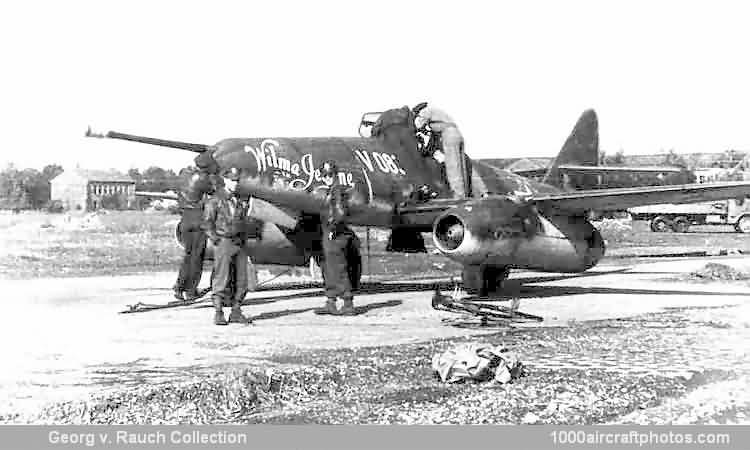02/28/2009. Remarks by Johan Visschedijk: "In an attempt to fight the large allied bomber packs that flew over Germany in late 1944 - early 1945, Messerschmitt fitted a Me 262 A-1a (c/n 130083) with an 1.97 in (50 mm) Mauser BK 5 cannon, to become a Pulkzerstörer (formation destroyer). After initial testing at the companies test field at Lager-Lechfeld, two more Me 262 A-1a's, c/n 111899 and 170083, were converted and designated Me 262 A-1a/U4. Wearing the test code "V899" and "V083" respectively, they were flown and tested from Lager-Lechfeld during March and April, 1945.
On April 16, 1945, a Me 262 A-1a/U4 was reported engaging a formation of B-26 Marauders, however, this report is likely erroneously, as there is no record of such an engagement.
The "V083" and "V899" were fitted with a 50 mm Rheinmetall-Mauser Mk.214A V3 cannon with a very efficient hydraulic recoil-damping system. It carried 22 projectiles of 4 lb (1.54 kg) each, that could be fired at a rate of 45 rounds/min. The entire nose section was redesigned for the large and heavy (1,080 lb, 490 kg) cannon, while the nose wheel mechanism was reconstructed to swivel 90º to retract horizontally into the bay beneath the cannon.
The pictured aircraft ("V083") was found early May 1945 at Lager-Lechfeld by Colonel Harold E. Watson and his team (known as Watson´s Whizzers), while retrieving valuable technology and equipment to be ferried back to the USA. Initially named Wilma Jeanne (after the wife of Watson's Whizzer Master-Sergeant Eugene Freiburger), and later renamed Happy Hunter II (after Watson's son), the aircraft was flown by Messerschmitt's Chief Test Pilot Karl Baur, while the American team conducted ground firing test, to be impressed by the recoil-damping system that hardly moved the aircraft.
To be shipped from Cherbourg, France, to Newark, New Jersey, USA aboard the HMS Reaper on July 19, 1945, "V083" was ferried from Lager-Lechfeld to Melun (near Paris), France, by Colonel Watson on June 10. On June 30, Messerschmitt's test pilot Ludwig 'Willi' Hofmann departed Melun for the final stage to Cherbourg. As a result to a disintegrating turbine disk the aircraft encountered severe vibration causing a tail plane malfunctioning, followed by an uncontrollable dive. At a speed of 500 mph (805 kmh) Hoffman bailed out to safety, sustaining several contusions and severe bruising, reportedly the aircraft crashed at Jersey, some 35 ml (60 km) from Cherbourg."
